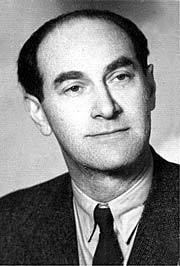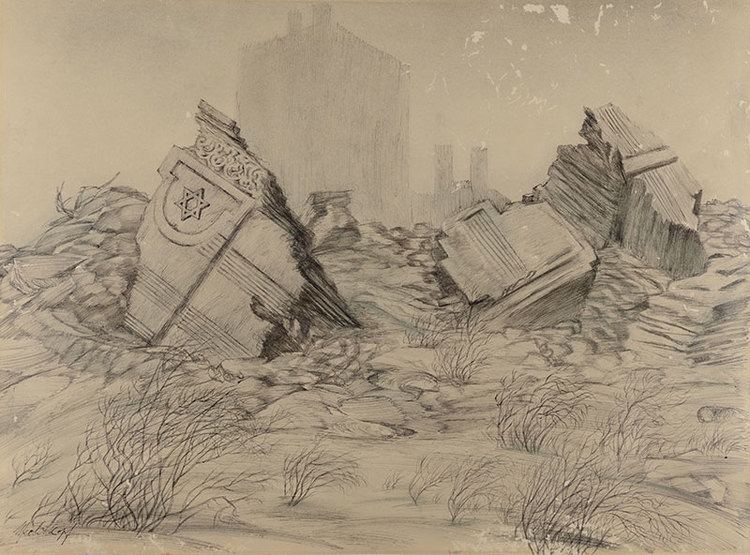Name Henryk Hechtkopf Movies Podhale w ogniu | Spouse Alicja Zielinska Role Artist | |
 | ||
Henryk Hechtkopf (Hebrew: הנריק הכטקופף; April 4, 1910 – July 2004) was an artist, painter, and illustrator.
Contents

Biography
Henryk Hechtkopf was an artist whose legacy is a rare collection of paintings in a variety of media, as well as illustrations for many children's books and Stories of The Tzadikim. Henryk Hechtkopf's work encompasses a range of subjects and artistic styles: biblical scenes and portraits, surrealism and abstract expressionism. His work is interesting not only by its own merits but because of the life story that stands behind it.
Henryk Hechtkopf was born to a Jewish family in Warsaw in 1910, the younger child of two. His father was a merchant, and his mother a midwife. Hechtkopf studied in the Hebrew Gymnasium "Chanoch" and then in Warsaw University. After obtaining his law degree, Hechtkopf became the first Jewish jurist to article at the Polish Supreme Court.
From early on, his artistic talent was evident. At the age of 23, his work was consistently selected to appear in the exhibitions of the "Jewish Society for Promotion of Art." Hechtkopf was also a filmmaker. He was involved in the making of several films before the outbreak of World War II, including Poland's first animated film.
While Hechtkopf's work was always very strongly informed by his Jewish background, drawing on religious symbolism and Jewish life in the Shtetl, his experiences during WWII were to have a profound impact on his work. At the beginning of the war, he retreated with the Polish army east into the Soviet Union, where he was captured and sent to work in a series of forced labor camps. After the war, he returned to Poland to find that his whole family had been massacred in the Holocaust. Hechtkopf 's drawings in the weeks following his return to Warsaw portrayed the ruins of the ghetto and the city which surrounded it. Twenty-four of these works were purchased by the Yad Vashem Holocaust memorial in Israel. Yehudit Shendar, the art curator of Yad Vashem has commented on the strong impact that Hechtkopf's work has on the viewer, as a first-hand account of destruction and despair. Hechtkopf designed in 1949 the first Polish stamp commemorating the Holocaust, and won first prize in an international competition for posters on the theme of Holocaust and heroism.
After the war, Hechtkopf was offered a position as a judge in Warsaw, but decided instead to move to Łódź, which was then the center of artistic life in Poland. In Łódź, he met his wife Alicja Zielinska. She has a sister Teresa Materne (Zielinska), who lives in Łódź (Poland) to this day. When his wife died on 15 September 1989, Henryk keep good contact with the wife's sister.
He helped establish the Jewish artist's society in Łódź, which he headed from 1946 to 1950. He also taught film at the Łódź film school, where Roman Polanski numbered among his students. Before leaving Poland for Israel in 1957, Hechtkopf directed together with Jan Batory, Poland's first post-war non-documentary successful film, "Forbidden Melodies" (1956).
Upon his arrival in Israel, Hechtkopf settled in Bat Yam, where he remained for the rest of his life, working as a painter and as an illustrator of books. While he employed different styles and techniques, his strong sensitivity and particular identity are evident in all his work. His wife died in 1989. Henryk Hechtkopf died in July 2004, at the age of 94. While they left behind no heirs, Hechtkopf claimed that his paintings were his children.
Exhibitions
1963 – Society of Artists and Sculptors, Tel Aviv. Beitan Alcharizi
1963 – David Ben Ari Museum, Bat Yam
1966 - Beit Yad Lebanim Museum. Petach Tikva
1972 - David Ben Ari Museum, Bat Yam
1972 – Jerusalem Day Exhibition, Beit Haam, Jerusalem
1979 – Jerusalem Day Exhibition, Beit Ribak Museum, Bat Yam
1993 – 50 Years Since the Warsaw Ghetto Uprising Exhibition, Beit Ribak Museum, Bat Yam
1996 – Biblical Drawings Exhibition, Mishkan Omanot Museum, Ein Harood
1997 – Biblical Exhibition, Beit Ribak, Bat Yam
1997 – Debbie and Ori Nachushtan Museum, Asdot Yaakov
1997 – Corrine Maman Museum, Ashdod
1998 – Biblical Drawings Exhibition, Biblical Museum, Beit Diezengoff, Tel Aviv
2009 – planned Tel Aviv Drawings Exhibition in commemoration of Tel Aviv's 100 year anniversary, Beit Diezengoff, Tel Aviv (At the request of the Director of Beit Hatanach, Mr. Dani Ofir).
Group exhibitions
Hechtkopf participated in dozens of group exhibitions in Israel and abroad. His work is exhibited the museum in Berkeley, CA, in the Jewish museum in Warsaw and in the Yad Vashem Holocaust Memorial in Jerusalem. In addition, his works were included exhibitions in Warsaw 1932-38. In addition, he exhibited in Lodz, Wroclaw, Kraków, Katovice.
Illustrations
Hechtkopf illustrated hundreds of books in his career, some of which would be recognized by anyone who has studied in the Israeli school system. Hechtkopf worked with top Israeli publishers, including Masada, Yavneh, Zimzun, Machanayim and Ofer. In addition, he served as the senior illustrator at Am Oved publishing house. He worked with several well-known Israeli authors, such as Benjamin Tene, Levin Kipnis, Rafael Saporta, Yemima Avidar-Tchernovitz, Asher Barash and others. Amongst the books that Hechtkopf illustrated:
Hechtkopf illustrated many of Israel's most popular children's books. Professor of literature Dr. Yael Dar has commented on the unique qualities of Hechtkopf's drawings and illustrations.
Prizes
Hechtkopf was also a portrait painter, that captured the images of young girls, children, laborers and tradesmen. In addition, his work includes several themed series of drawings, including: Tel Aviv, Jerusalem, Tzfat, Stories of Tzadikim, Biblical Stories, and others. He employed styles ranging from realism to surrealism and exciting abstract. In 1980, Hechtkopf was the only Israeli illustrator noted in an encyclopedia of great illustrators of the world "Something About the Author" – Commire, Gale Research, Detroit, Michigan, (Volume 17 p. 79).
